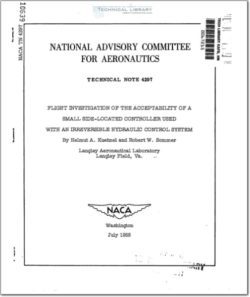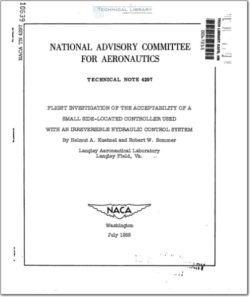NACA-TN-4297

- Version
- 153 Downloads
- 634.90 KB File Size
- 1 File Count
- December 4, 2015 Create Date
- December 4, 2015 Last Updated
National Advisory Committee for Aeronautics, Technical Notes - Flight Investigation of the Acceptability of a Small Side Loaded Controller used with an Irreversible Hydraulic Control System

A flight investigation has been conducted to determine the accept—
ability of a small side-located controller which is used as the primary
airplane controller in an irreversible hydraulic—power control system.
The particular controller used in this investigation requires up and
down hand motion pivoting at the wrist for longitudinal control and
lateral hand or forearm motion for lateral control. Pilot opinion was
obtained concerning the acceptability of the controller while performing
lateral and longitudinal maneuvers in a Jet-trainer airplane at
cruising-flight conditions.
The results of this investigation indicate that the location of
the controller is consistent with pilot comfort and the airplane is
flyable with the side-located controller. Hand motion about the wrist
pivot required for longitudinal control is somewhat uncomfortable when
large stick motions and high forces are required. Stick breakout force
and stick force gradient should be kept at low values consistent with
the reduced-force-output requirements of the pilot when operating a
small side-located controller of the type used in this investigation.
Because of the present interest in side-located controllers for
use in the primary airplane control system, the Flight Research Division
of the Langley Aeronautical Laboratory has conducted a flight evaluation
of a specific side-located controller. The side location of a primary
controller has been found to be desirable when the controller is used
with an electronic control system. In the electronic system the stick-
force characteristics can be infinitely varied and such things as link-
age friction, elasticity, and valve friction pose no problems. When
a side controller is used in conjunction with a hydraulic—power control
system, however, these factors assume primary importance in determining
acceptable stick force gradients and stick breakout force. Therefore,
the effects of linkage and valve friction on overall-control-system
quality should be investigated.
| File | Action |
|---|---|
| naca-tn-4297.pdf | Download |

Comment On This Post